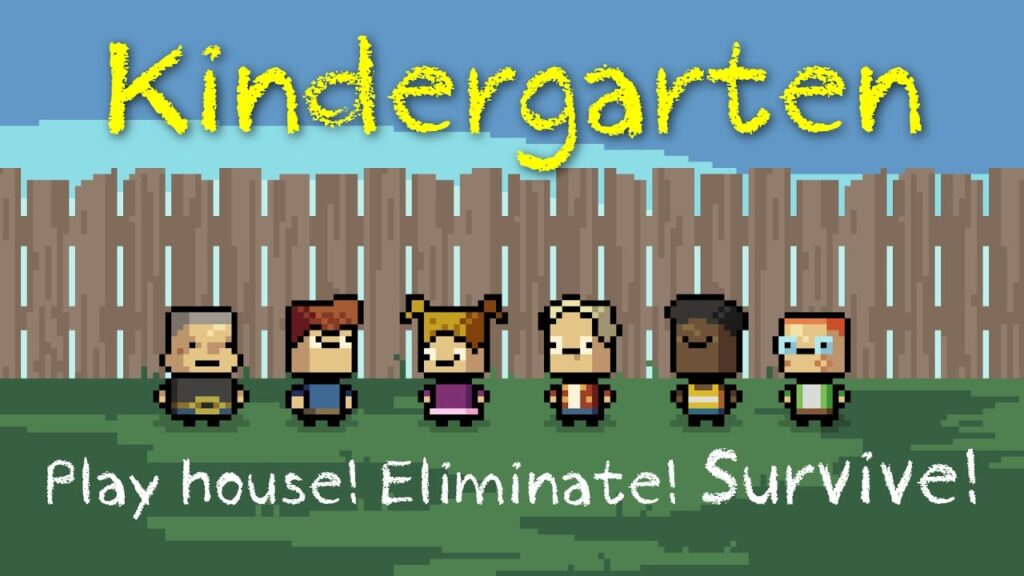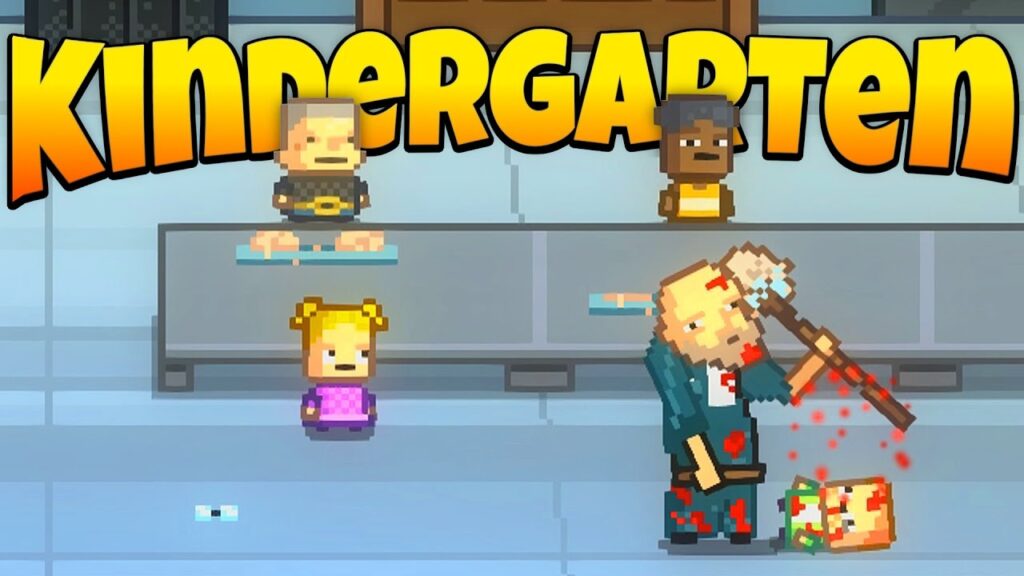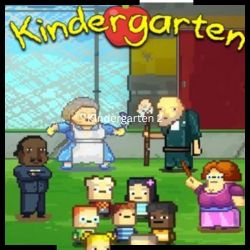Kindergarten (v1.4) Fully Activated And Free Game Download [Latest]
Steamunlocked:-Kindergarten is a crucial stage in a child’s development, where they begin to explore and make sense of the world around them. During this phase, educators employ various methods to engage children and promote their cognitive, social, and emotional growth. One powerful tool in a kindergarten cop classroom is the kindergarten game. This article will explore how these games provide a fun and effective way to enhance learning and development in young children.
Kindergarten games offer children an interactive and engaging learning experience. These games are designed to be age-appropriate, incorporating elements that captivate children’s attention and stimulate their curiosity. They often involve playful activities such as sorting, matching, counting, and problem-solving, which are essential skills for their cognitive development.

kindergarten worksheets games provide an excellent platform for children to develop and practice their social skills. These games often encourage collaboration, cooperation, and turn-taking, fostering positive interactions among children. Through these games, children learn to communicate effectively, share resources, and work as a team. Such experiences lay a foundation for building healthy relationships and developing crucial social-emotional skills.
kindergarten age games are educational activities designed specifically for young children attending kindergarten, typically between the ages of four and six. These games serve as interactive tools to engage children in a playful and stimulating learning environment while promoting their overall development.
The primary objective of kindergarten math worksheets games is to provide young learners with opportunities to acquire and practice essential skills across various domains, including cognitive, social, emotional, and physical development. These games are carefully designed to align with age-appropriate learning objectives and to cater to the unique needs and interests of kindergarten-aged children.
Kindergarten games offer a wide range of activities that encompass different subjects and skill areas. They can involve elements of literacy, numeracy, science, arts, and physical education, among others. These activities may include puzzles, memory games, sorting and matching exercises, creative arts and crafts, role-playing, outdoor games, and music and movement activities.
By incorporating games into the kindergarten curriculum, educators aim to make the learning process enjoyable, engaging, and effective. Kindergarten games serve as valuable tools to support children’s cognitive development by promoting critical thinking, problem-solving, and decision-making skills. They encourage children to explore and understand basic concepts, such as letter recognition, counting, shapes, colors, and spatial awareness.
In addition to cognitive development, kindergarten games play a crucial role in fostering social skills. These games often require children to work together, share resources, take turns, and communicate effectively. By engaging in collaborative activities, children learn to develop positive relationships, empathy, and teamwork.
Furthermore, kindergarten games contribute to the physical development of children. Through games that involve physical movements, such as running, jumping, balancing, and throwing, children enhance their motor skills, coordination, and overall physical abilities. These activities not only promote healthy physical development but also encourage an active and energetic lifestyle.
Key Features
- Age Appropriateness: Kindergarten games are specifically designed to suit the developmental needs and abilities of children between the ages of four and six. They incorporate content and activities that align with the cognitive, social, emotional, and physical capabilities of kindergarten-aged children.
- Playful and Engaging: Kindergarten games aim to make the learning process enjoyable and interactive. They incorporate elements of play, such as colorful visuals, interesting characters, and engaging narratives, to capture children’s attention and keep them motivated throughout the game.
- Learning Objectives: Each kindergarten game is designed with specific learning objectives in mind. Whether it is developing literacy skills, numeracy skills, problem-solving abilities, or social-emotional competencies, these games are tailored to reinforce and practice key concepts and skills relevant to the kindergarten curriculum.
- Variety of Activities: Kindergarten games offer a wide range of activities to cater to different learning styles and interests. They may include puzzles, memory games, sorting and matching exercises, creative arts and crafts, role-playing, outdoor games, and music and movement activities. This variety ensures that children have diverse opportunities to engage and learn.
- Progression and Adaptability: Kindergarten games often provide a progression of difficulty levels to accommodate children’s varying abilities. They may start with simpler tasks and gradually increase the complexity as children become more proficient. This adaptability allows children to learn at their own pace and provides appropriate challenges to stimulate their growth.
- Social Interaction: Many kindergarten games incorporate elements of social interaction, promoting collaboration, cooperation, and communication among children. These games encourage teamwork, turn-taking, sharing, and empathy, fostering positive social skills and interpersonal relationships.
- Hands-on Learning: Kindergarten games often involve hands-on activities that require children to manipulate objects, use their senses, and actively participate in the learning process. These hands-on experiences enhance children’s understanding of abstract concepts and facilitate their cognitive development.
- Feedback and Reinforcement: Kindergarten games provide feedback and reinforcement to children, acknowledging their achievements and guiding them in areas that require improvement. This feedback can be in the form of visual cues, positive reinforcement, or corrective prompts, helping children build confidence and develop a growth mindset.
Pros And Cons
Pros:
- Engaging and Enjoyable: Kindergarten games make learning fun and enjoyable for young children. By incorporating elements of play, colorful visuals, and interactive activities, these games capture children’s interest and keep them engaged throughout the learning process.
- Holistic Development: Kindergarten games promote the overall development of children by targeting various domains, including cognitive, social, emotional, and physical skills. These games provide opportunities for children to practice essential skills in a comprehensive and integrated manner.
- Active Learning: Kindergarten games often involve hands-on activities that require children to actively participate and manipulate objects. This active learning approach enhances their understanding and retention of concepts, fostering critical thinking and problem-solving skills.
- Individualized Pace: Many kindergarten games offer adaptive features, allowing children to learn at their own pace. These games provide appropriate challenges based on a child’s progress, ensuring that they are neither overwhelmed nor bored with the content.
- Social Interaction: Kindergarten games often encourage collaboration, cooperation, and communication among children. By working together, taking turns, and sharing resources, children develop important social skills, such as teamwork, empathy, and effective communication.
- Skill Reinforcement: Kindergarten games provide opportunities for children to reinforce and practice key skills and concepts. Through repetition and feedback, these games help children solidify their understanding and build confidence in their abilities.
Cons:
- Overreliance on Technology: With the integration of technology in many kindergarten games, there is a risk of overdependence on screens and digital devices. Excessive screen time may limit children’s exposure to other types of play and real-world experiences, affecting their development in other areas.
- Lack of Personalized Instruction: While kindergarten games can be adaptive to some extent, they may not fully address the individual learning needs of each child. Some children may require additional support or alternative approaches that cannot be provided solely through games.
- Limited Physical Activity: Certain kindergarten games, particularly those that are screen-based, may limit children’s physical activity. A sedentary lifestyle can have negative consequences on children’s health and well-being, requiring a balance between screen time and active play.
- Potential for Superficial Learning: Although kindergarten games can be effective in introducing and reinforcing concepts, there is a risk of children relying solely on surface-level understanding. It is essential to supplement game-based learning with hands-on experiences and meaningful interactions to ensure deeper comprehension.
- Access and Equity: Kindergarten games that rely on technology may pose challenges in terms of access and equity. Not all children may have equal access to devices or stable internet connections, potentially creating disparities in their learning opportunities.
- Distractions and Loss of Focus: Some children may find it challenging to stay focused and engaged during kindergarten games, especially if they are easily distracted. It is important to monitor and provide guidance to ensure that children are actively participating and benefiting from the games.
System Requirements
- Operating System: The game may require a specific operating system, such as Windows, macOS, iOS, or Android. The version of the operating system should also be checked to ensure compatibility.
- Processor: The game’s system requirements may specify a minimum processor type and speed. For example, it may require an Intel Core i3 or equivalent processor.
- RAM (Memory): The game may have minimum and recommended RAM specifications. It is recommended to have the recommended amount of RAM for optimal performance. For example, the game may require a minimum of 4GB RAM, but 8GB RAM may be recommended for smoother gameplay.
- Graphics Card: Some games, particularly those with advanced graphics or 3D elements, may require a dedicated graphics card. The system requirements will specify the minimum graphics card requirements, such as NVIDIA GeForce or AMD Radeon models, along with the necessary graphics memory.
- Storage Space: The game’s system requirements will indicate the amount of available storage space needed for installation. This can vary depending on the game’s size and additional downloadable content (DLC) if applicable.
- Display: The game may have specific resolution and aspect ratio requirements. It is important to ensure that the display resolution of the device meets or exceeds the minimum requirements for optimal gameplay experience.
- Input Devices: The game may require specific input devices, such as a keyboard, mouse, touch screen, or game controller. The system requirements should specify the supported input devices and any additional peripherals needed.
How to install
- Obtain the Game: Depending on the source, you can obtain the game through various methods. It could be a physical copy from a retail store or an online purchase from a digital platform or website. Make sure you have the necessary access to the game files.
- Check System Requirements: Before proceeding with the installation, ensure that your computer, tablet, or mobile device meets the system requirements specified by the game. This includes checking the operating system, processor, memory (RAM), storage space, and any other hardware or software requirements mentioned by the game’s developer.
- Prepare Your Device: Ensure that your device has sufficient storage space available to install the game. Remove any unnecessary files or applications to free up space if needed. It’s also a good idea to close any other programs or applications running in the background to avoid any conflicts during the installation process.
- Run the Installer: If you have a physical copy of the game, insert the game disc into your computer’s disc drive. Alternatively, if you purchased the game digitally, locate the downloaded game file on your device. Double-click the installer file or follow any prompts provided to begin the installation process.
- Follow the Installation Wizard: The game installation process typically involves an installation wizard that guides you through the necessary steps. Follow the on-screen instructions, including accepting the license agreement, selecting the installation location, and choosing any additional options if presented.
- Wait for Installation: Once you’ve made the necessary selections, the installation process will begin. This may take a few moments or longer, depending on the size of the game and the speed of your device. During this time, avoid interrupting the installation process or turning off your device.
- Launch the Game: After the installation is complete, you may be prompted to launch the game automatically. If not, locate the game icon on your desktop, Start menu, or applications folder, and double-click it to start the game.

Final words
Steam Unlocked:-In conclusion, a kindergarten game offers a wonderful opportunity for young children to engage in interactive and educational play. With its focus on age-appropriate activities, these games provide a platform for children to develop and enhance essential skills across various domains, including cognitive, social, emotional, and physical development.
By incorporating elements of play and interactivity, kindergarten games make learning enjoyable and captivating for children. They offer a holistic approach to education, targeting different areas of development simultaneously, and promoting a well-rounded learning experience.
